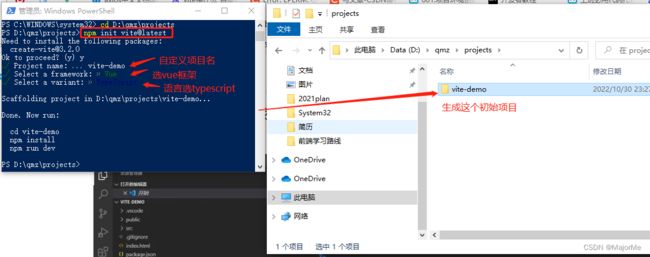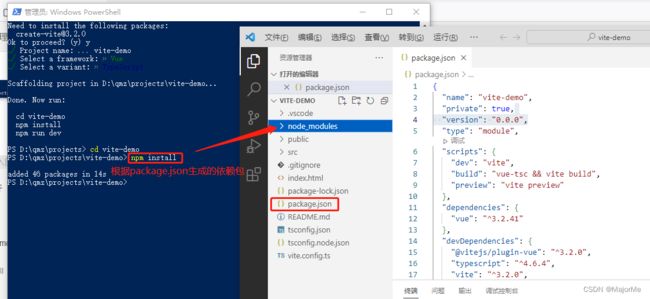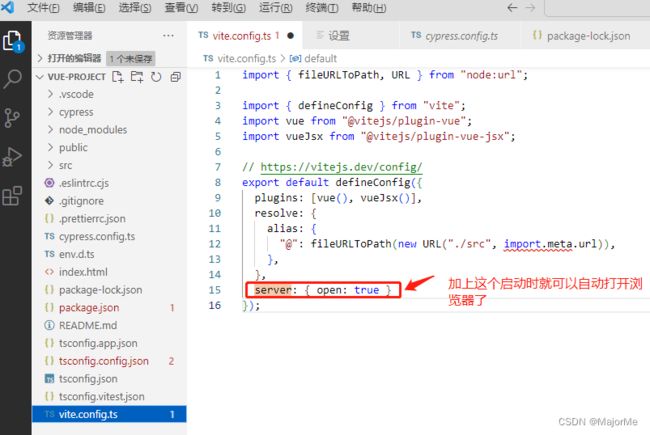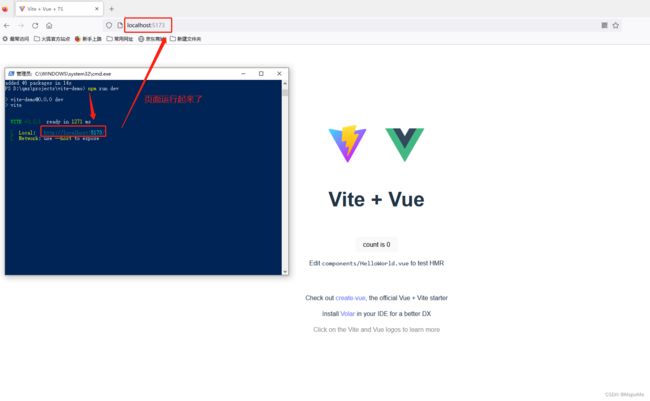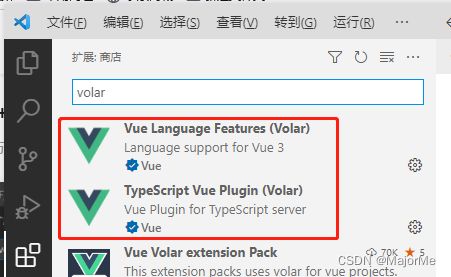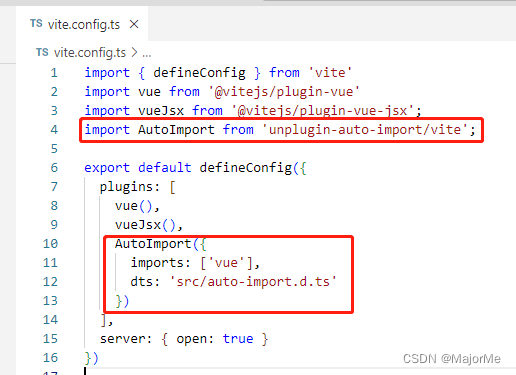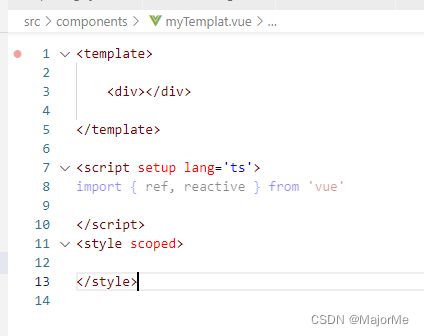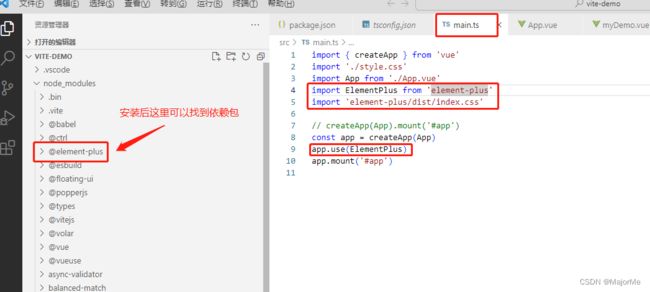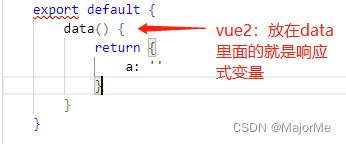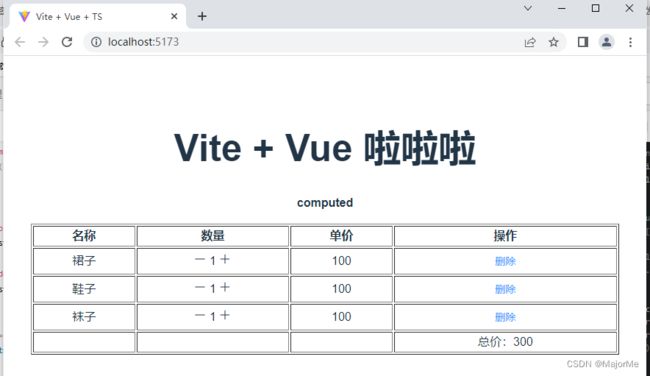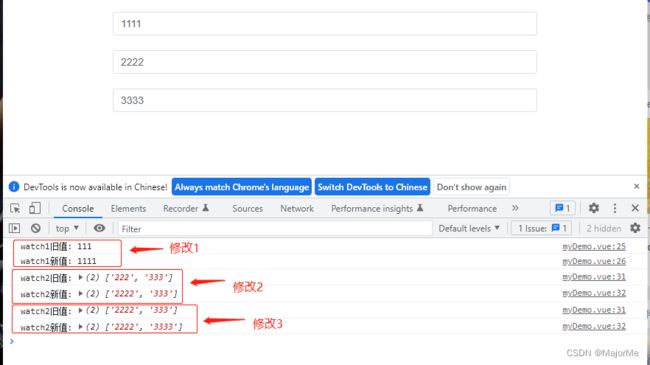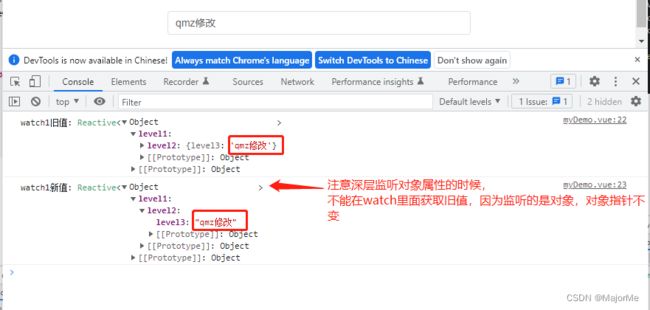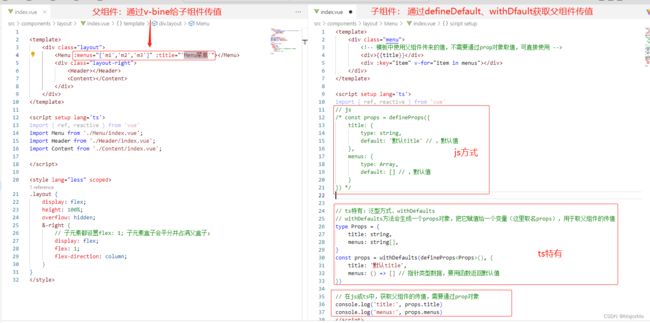Vue3 + vite + Ts + pinia + 实战 +electron(学习ing,笔记未完待续......)
文章目录
-
- 一、构建项目
-
- 1、创建项目
- 2、安装依赖
- 3、运行
- 4、安装插件
- 5、配置用户代码块
- 6、安装UI组件库ElementPlus
- 7、搭建页面layout,认识less、scoped、一些css新特性
- 二、vue3基础使用学习
-
- 1、模板语法&vue指令
- 2、Vue核心虚拟Dom和 diff 算法(了解)
- 3、ref和reactive
- 4、toRef、toRefs、toRaw
- 5、computed计算属性
- 6、watch监听
- 7、watchEffect高级监听
- 8、生命周期
- 9、父子组件传参
- 10、全局组件注册
- 11、动态组件
- 12、插槽
- 13、异步组件(涉及性能优化)
- 14、Teleport传送组件
- 15、keep-alive缓存组件
- 16、依赖注入Provide / Inject
- 17、兄弟组件传参
- 18、tsx组件
- 19、v-model
- 20、自定义指令
- 21、自定义hook
- 22、定义全局函数和全局变量
- 23、
一、构建项目
1、创建项目
npm init vite@latest
或使用npm init vue@latest,这种方式配置多一点,包括router,pinia等,专门为构建vue用的,齐全一点,vite(vite? 、vite和webpack区别?)可以构建其他项目,比如react或其他,下面是用第一种方式npm init vite@latest:
2、安装依赖
进入vite-demo目录,安装依赖(根据项目中的package.json文件安装依赖)
npm install
3、运行
- 设置默认启动项目自动开启浏览器:
server: { open: true }
- 运行项目
npm run dev
4、安装插件
1、 Vue Language Features (Volar), TypeScript Vue Plugin (Volar)插件
注意:若之前开发vue2有安装vetur插件(对.vue文件中的语法进行高亮显示),开发vue3需要禁用这个插件
2、AutoImport插件
安装插件:npm i -D unplugin-auto-import
import { defineConfig } from 'vite'
import vue from '@vitejs/plugin-vue'
import vueJsx from '@vitejs/plugin-vue-jsx';
import AutoImport from 'unplugin-auto-import/vite';
export default defineConfig({
plugins: [
vue(),
vueJsx(),
AutoImport({
imports: ['vue'],
dts: 'src/auto-import.d.ts'
})
],
server: { open: true }
})
<template>
<div class="parent">
// 省略了.value
<button @click="flag=!flag">切换</button>
{{flag}}
</div>
</template>
<script setup lang='ts'>
import { ref, reactive } from 'vue'
let flag = ref<boolean>(true)
</script>
5、配置用户代码块
- 配置
设置—配置用户代码片段—选择vue(vue)或者vue.json(vue)


把下面代码复制到vue.json里面
{
"Print to console": {
"prefix": "vue3",
"body": [
"",
"",
" ",
"",
"",
"",
"",
// 注意 lang='less'前提是安装了less,安装方法在第7点
""
],
"description": "Log output to console"
}
}
6、安装UI组件库ElementPlus
1)官方说明文档:
-
官方教程
-
快速开始
2)安装element-plus
- 在项目路径下执行命令安装:
npm install element-plus --save
- 安装成功后,全局配置(main.ts):
// main.ts
import { createApp } from 'vue'
import './style.css'
import App from './App.vue'
import ElementPlus from 'element-plus' // 引入ElementPlus 组件
import 'element-plus/dist/index.css' // 引入ElementPlus 组件样式
// createApp(App).mount('#app')
const app = createApp(App)
app.use(ElementPlus) // 使用ElementPlus组件
app.mount('#app')
此外还有其他导入方式(自动导入/按需导入、手动导入),请参考官方使用教程
- 使用示例(按钮组件)
<template>
<div>
<ElButton>按钮</ElButton >
</div>
</template>
<script setup lang="ts">
import { ElButton } from 'element-plus' // 引入按钮组件
</script>
3)安装icon图标
- 安装
npm install @element-plus/icons-vue
- 注册所有图标(main.ts)
// main.ts
// 如果您正在使用CDN引入,请删除下面一行。
import * as ElementPlusIconsVue from '@element-plus/icons-vue'
const app = createApp(App)
for (const [key, component] of Object.entries(ElementPlusIconsVue)) {
app.component(key, component)
}
- 使用示例
7、搭建页面layout,认识less、scoped、一些css新特性
1)less的安装和使用
- 安装less
在项目根目录下执行以下命令:
npm install less less-loader -D
- 使用声明
<style lang="less" scoped>
</style>
2)了解和配置css reset
- 什么是css rest ?
由于浏览器支持和理解的CSS 规范不同,导致渲染页面效果不一致,会出现很多兼容性问题,比如旧 IE 浏览器不支持 HTML5+标签,不同浏览器对 CSS 行为也不统一,这就导致两个问题:
处理浏览器的兼容性。 跨浏览器样式表现统一。为解决上面问题,出现了CSS Reaet ,根据对默认样式的改写的轻重程度,可分为三类:
完全重置——硬重置。 规范化重置——软重置。 个性化重置。
- 配置css reset
在src\assets\ 下新建css\reset.less,把css reset样式代码复制到reset.less文件中,如下:
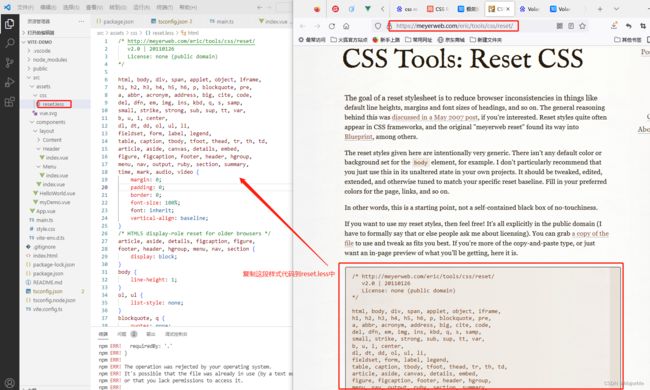 然后修改一下,初始化html,body,#app外层样式:
然后修改一下,初始化html,body,#app外层样式:

接下来在src\main.ts文件中全局进入:
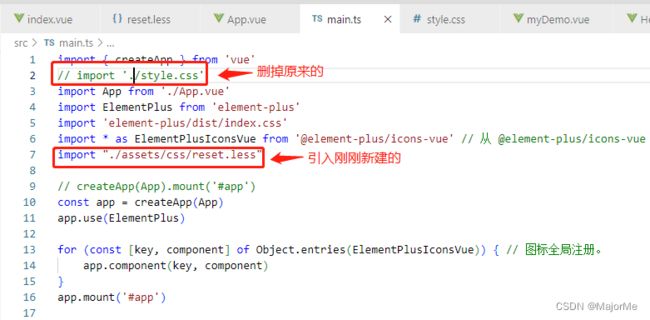
3)layout页面构建
layout包括:Menu、Header、Content
 如图创建相应文件夹和文件:
如图创建相应文件夹和文件:
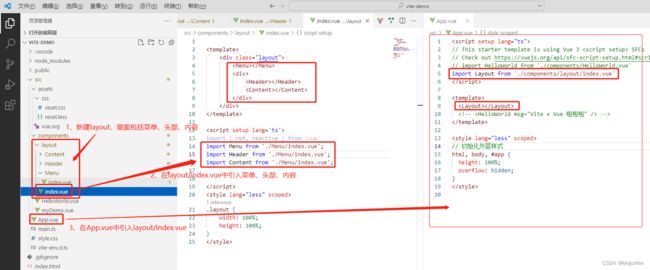
4)scoped的作用
隔离样式:
 渲染页面的标签会出现 data-v-xxx 属性隔离样式:
渲染页面的标签会出现 data-v-xxx 属性隔离样式:

5)vue3的一些css新特性
<style>
// deep选择器 一般用于修改组件库里的组件的样式
/deep/ .el_input_inner {
border: 1px solod pink;
}
// 或者
:deep(.el_input_inner) {
border: 1px solod pink;
}
// 插槽选择器:sloted
:sloted(.className) {
color:blue;
}
// 全局选择器:global
:global(.className) {
color:pink;
// 动态css绑定v-bine
.className {
color: v-bine(colorVal); // 假设 let colorVal = ref('pink')
// 或
color: v-bine('obj.colorVal'); // 假设 let obj = ref({colorVal: 'pink'})
}
</style>
6)其他
二、vue3基础使用学习
1、模板语法&vue指令
v- 开头都是vue 的指令
v-text 用来显示文本
v-html 用来展示富文本
v-if 用来控制元素的显示隐藏(切换真假DOM)
v-else-if 表示 v-if 的“else if 块”。可以链式调用
v-else v-if条件收尾语句
v-show 用来控制元素的显示隐藏(display none block Css切换)
v-on 简写@ 用来给元素添加事件
v-bind 简写: 用来绑定元素的属性Attr
v-model 双向绑定
v-for 用来遍历元素
v-on修饰符
参考案例
2、Vue核心虚拟Dom和 diff 算法(了解)
Vue3 源码地址
3、ref和reactive
1) vue2和vue3的双向绑定值定义区别
- vue2:
- vue3:使用ref或者reactive包裹,或者自定义customRef
- ref接受一个内部值并返回一个响应式且可变的 ref 对象。ref 对象仅有一个 .value property,指向该内部值。
- 使用案例
<template>
<div>啦啦a:{{a}}</div>
<button @click="change">变变变</button>
<form>
<input />
</form>
</template>
<script setup lang="ts">
import { ref, reactive, isRef } from 'vue'
const a = ref("我是a") // 对象
const change = () => {
a.value = "a变身" // 赋值的时候需要.value赋值,否则直接a=xxx会报错
}
</script>
3)reactive
<template>
<div>啦啦b:{{b.val}}</div>
<button @click="change">变变变</button>
<form>
<input />
</form>
</template>
<script setup lang="ts">
import { ref, reactive, isRef } from 'vue'
const b = reactive({
val: "我是b"
})
const change = () => {
b.val = "b变身"
}
</script>
- 特别注意:reactive声明的对象和数组,再次赋值不能直接整个赋值,整个赋值页面不会更新。
// 假设
const arr = reactive([]);
const obj= reactive({});
const res = [1,2,3]
const res2 = {a:'1', b: '2'}
直接赋值,即使打印生效,页面也不会更新:
// arr = res // 不可以
// arr.concat(res) // 不可以
// obj = res2 // 不可以
原因: vue3使用proxy,arr= newArr让arr失去了响应性,所以对于对象和数组都不能直接整个赋值:
如何解决?
数组:用push
res.forEach(e => { // 可以
arr.push(e);
});
arr.push(...[1, 2, 3]) // 可以
};
对象:改用ref定义
const obj= ref({});
obj.value = {...res2 } // 可以
其他方法:用reactive封装一层,然后使用toRefs解构(待验证)
<script setup lang='ts'>
const state = reactive({
arr: [],
obj:{}
});
state.arr = [1, 2, 3]
state.obj={...res2}
const { form,obj} = toRefs(state)
4)shallowRef、shallowReactive
只能对浅层的数据,如果是深层的数据只会改变值(打印的是改变的值),不会改变视图(页面不会刷新)
4、toRef、toRefs、toRaw
- toRef、toRefs
注意: 只能解构响应式对象的值
<template>
<div>name:{{name}}</div>
<div>age:{{age}}</div>
<div>num:{{num}}</div>
<button @click="change">变变变</button>
<form>
<input />
</form>
</template>
<script setup lang="ts">
import { ref, toRef, toRefs, reactive, isRef } from 'vue'
const myInfo = ref({ // 或者 reactive
name: 'zz',
age: 18,
num: 520
})
// toRef只能解构响应式对象的值,对普通对象(如const myInfo={name:'zz', age: 18, num: 520})则行不通
const { name, age } = toRefs(myInfo.value) // toRefs: 若myInfo使用reactive定义,则这里解构改为 const { name, age } = toRefs(myInfo)
const num = toRef(myInfo.value, "num") // toRef:若myInfo使用reactive定义,则这里解构改为 const num = toRef(myInfo, "num")
const change = () => {
name.value = 'zx'
age.value = 3
num.value = 1314
console.log("name:",name)
}
</script>
- toRaw
把响应式的对象转为普通对象
<script setup lang="ts">
import { ref, toRef, toRefs, reactive, isRef, toRaw } from 'vue'
let myInfo = reactive({
name: 'zz',
age: 18,
num: 520
})
const { name, age } = toRefs(myInfo)
const num = toRef(myInfo, "num")
console.log("name:",name)
console.log("toRaw前的myInfo:",myInfo)
const change = () => {
name.value = 'zx'
age.value = 3
num.value = 1314
// myInfo = toRaw(myInfo)
console.log("toRaw(myInfo):", toRaw(myInfo))
}
</script>
5、computed计算属性
计算属性就是当依赖的属性的值发生变化的时候,才会触发他的更改,如果依赖的值,不发生变化的时候,使用的是缓存中的属性值。
案例:
<template>
<p style="font-weight: bold;">computed</p>
<div>
<table border style="width:800px;text-align: center;">
<thead>
<tr>
<th>名称</th>
<th>数量</th>
<th>单价</th>
<th>操作</th>
</tr>
</thead>
<tbody>
<tr :key="'item' + index" v-for="(item, index) in list">
<td>{{item.name}}</td>
<td>
<el-icon class="point" @click="minus(index)"><Minus /></el-icon>
{{item.num}}
<el-icon class="point" @click="plus(index)"><Plus /></el-icon>
</td>
<td>
{{item.num * item.price}}
</td>
<td>
<ElButton
type="primary"
text
@click="delet(index)"
>删除</ElButton
>
</td>
</tr>
<tr>
<td></td>
<td></td>
<td></td>
<td>总价:{{total}}</td>
</tr>
</tbody>
</table>
</div>
</template>
<script setup lang="ts">
import { ref, reactive, computed } from 'vue'
import { ElButton } from 'element-plus'
type goodInfo = {
name: string,
num: number,
price: number
}
let total = ref<number>(0)
const list = reactive<goodInfo[]>(
[
{
name: '裙子',
num: 1,
price: 100
}, {
name: '鞋子',
num: 1,
price: 100
}, {
name: '袜子',
num: 1,
price: 100
}
]
)
const minus = (index:number) => {
if(list[index].num > 0) {
list[index].num = list[index].num - 1
}
}
const plus = (index:number) => {
list[index].num = list[index].num + 1
}
const delet = (index:number) => {
list.splice(index, 1)
}
total = computed<number>(() => {
return list.reduce((prev, next) => {
return prev + (next.num*next.price)
}, 0)
})
</script>
<style scoped>
.point {
cursor: pointer;
}
</style>
6、watch监听
watch 需要侦听特定的数据源,并在单独的回调函数中执行副作用
watch第一个参数监听源
watch第二个参数回调函数cb(newVal,oldVal)
watch第三个参数一个options配置项是一个对象{
immediate:true //是否立即调用一次
deep:true //是否开启深度监听
- 监听普通类型
<template>
<p style="font-weight: bold;">computed</p>
<div>
<el-input style="margin: 10px 0" v-model="input1"/>
<el-input style="margin: 10px 0" v-model="input2"/>
<el-input style="margin: 10px 0" v-model="input3"/>
</div>
</template>
<script setup lang="ts">
import { ref, reactive, computed, watch } from 'vue'
import { ElInput } from 'element-plus'
let input1 = ref('111')
let input2 = ref('222')
let input3 = ref('333')
watch(input1, (newValue, oldValue) => {
console.log('watch1旧值:', oldValue)
console.log('watch1新值:', newValue)
})
// 监听多个数据, watch的第一个参数要用数组形式
watch([input2, input3], (newValue, oldValue) => {
console.log('watch2旧值:', oldValue)
console.log('watch2新值:', newValue)
})
</script>
<style scoped>
</style>
依次修改三个值,监听打印如下:
- 监听深层对象
<template>
<p style="font-weight: bold;">computed</p>
<div>
<el-input v-model="obj.level1.level2.level3"/>
</div>
</template>
<script setup lang="ts">
import { ref, reactive, computed, watch } from 'vue'
import { ElInput } from 'element-plus'
let obj = ref({ // ref改为reactive,则watch函数不需要设置deep参数,始终可以深度监听
level1: {
level2: {
level3: 'qmz'
}
}
})
watch(
obj,
(newValue, oldValue) => {
console.log('watch1旧值:', oldValue)
console.log('watch1新值:', newValue)
},
{ deep: true }
)
</script>
- 监听reactive 单一值
import { ref, watch ,reactive} from 'vue'
let message = reactive({
val1:"",
val2:""
})
watch(()=>message.name, (newValue, oldValue) => {
console.log('新值----', newValue);
console.log('旧值----', oldValue);
})
7、watchEffect高级监听
watchEffect相当于将watch 的依赖源和回调函数合并,当任何你有用到的响应式依赖更新时,该回调函数便会重新执行。不同于
watch,watchEffect 的回调函数会被立即执行(即 { immediate: true })
- 非惰性(立即执行)
<script setup lang="ts">
import { watchEffect } from 'vue'
watchEffect(() => {
console.log('不管有没有监听对象,渲染页面或者刷新页面,都会立即执行')
}
)
</script>
- 不需要传递你要侦听的内容,自动会感知代码依赖(就是watchEffect内用到了哪个响应式变量,就监听哪个变量)
<template>
<p style="font-weight: bold;">watchEffect</p>
<div>
<el-input v-model="inputVal.value"/>
</div>
</template>
<script setup lang="ts">
import { ref, reactive, computed, watchEffect } from 'vue'
import { ElInput } from 'element-plus'
let inputVal = reactive({
value: '1'
})
watchEffect(() => {
console.log("inputVal.value:", inputVal.value) // 用到inputVal.value,只要它变化了,自动监听到
}
)
</script>
- watchEffect的副作用
副作用就是执行某种操作,如对外部可变数据或变量的修改,外部接口的调用等。watchEffect的回调函数就是一个副作用函数,因为我们使用watchEffect就是侦听到依赖的变化后执行某些操作。
- 清除副作用应用
在触发监听之前会调用一个函数可以处理你的逻辑,例如:
1)节流防抖
// 节流防抖
<script setup lang="ts">
import { ref, reactive, computed, watchEffect } from 'vue'
import { ElInput } from 'element-plus'
const id = ref(13)
watchEffect(onInvalidate => {
// 异步请求
const token = performAsyncOperation(id.value)
// 如果id频繁改变,会触发失效函数,取消之前的接口请求
onInvalidate(() => {
// id has changed or watcher is stopped.
// invalidate previously pending async operation
token.cancel()
})
})
const performAsyncOperation = (id) => {
// 这是一个请求接口操作(异步操作)
}
</script>
2)定时器注册和销毁
<script setup lang="ts">
import { ref, watchEffect, onMounted } from 'vue'
import { ElInput } from 'element-plus'
// 定时器注册和销毁
watchEffect((onInvalidate) => {
const timer = setInterval(()=> {
// ...
}, 1000)
onInvalidate(() => clearInterval(timer))
})
</script>
3)dom的监听和取消监听
<script setup lang="ts">
import { ref, watchEffect, onMounted } from 'vue'
import { ElInput } from 'element-plus'
const handleClick = () => {
// ...
}
// dom的监听和取消监听
onMounted(()=>{
watchEffect((onInvalidate) => {
document.querySelector('.btn').addEventListener('click', handleClick, false)
onInvalidate(() => document.querySelector('.btn').removeEventListener('click', handleClick))
})
)}
</script>
- 停止监听
<template>
<div style="margin: 10px 0">
<el-input v-model="inputVal1"/>
</div>
<el-button type="primary" @click="stop" >停止监听</el-button>
</template>
<script setup lang="ts">
import { ref, watchEffect, onMounted } from 'vue'
import { ElInput, ElButton } from 'element-plus'
let inputVal1 = ref('111')
const stop = watchEffect((onInvalidate) => {
console.log('inputVal1:', inputVal1)
})
</script>
- 副作用刷新时机 flush (一般使用post)
| pre | sync | post | |
|---|---|---|---|
| 刷新时机 | 组件更新前执行 | 强制效果始终同步触发 | 组件更新后执行 |
8、生命周期
参考笔记
9、父子组件传参
1)父组件给子组件接收传参
// ts特有
type Props = {
title: string,
menus: string[],
}
const props = withDefaults(defineProps<Props>(), {
title: '默认title',
menus: () => [] // 注意:指针类型数据,要用函数返回默认值
})
// 抛出事件
// const emit = defineEmits(['click1', 'click2']) // js方式
const emit = defineEmits<{ // ts特有方式
(e: 'click1', id: string): void
(e: 'click2', value: string): void
}>()
defineExpose 使用 script setup 的组件是默认关闭的,也即通过模板 ref 或者 $parent
链获取到的组件的公开实例,不会暴露任何在
